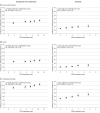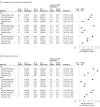Association Between Depressive Symptoms and Incident Cardiovascular Diseases
- PMID: 33320224
- PMCID: PMC7739139
- DOI: 10.1001/jama.2020.23068
Association Between Depressive Symptoms and Incident Cardiovascular Diseases
Abstract
Importance: It is uncertain whether depressive symptoms are independently associated with subsequent risk of cardiovascular diseases (CVDs).
Objective: To characterize the association between depressive symptoms and CVD incidence across the spectrum of lower mood.
Design, setting, and participants: A pooled analysis of individual-participant data from the Emerging Risk Factors Collaboration (ERFC; 162 036 participants; 21 cohorts; baseline surveys, 1960-2008; latest follow-up, March 2020) and the UK Biobank (401 219 participants; baseline surveys, 2006-2010; latest follow-up, March 2020). Eligible participants had information about self-reported depressive symptoms and no CVD history at baseline.
Exposures: Depressive symptoms were recorded using validated instruments. ERFC scores were harmonized across studies to a scale representative of the Center for Epidemiological Studies Depression (CES-D) scale (range, 0-60; ≥16 indicates possible depressive disorder). The UK Biobank recorded the 2-item Patient Health Questionnaire 2 (PHQ-2; range, 0-6; ≥3 indicates possible depressive disorder).
Main outcomes and measures: Primary outcomes were incident fatal or nonfatal coronary heart disease (CHD), stroke, and CVD (composite of the 2). Hazard ratios (HRs) per 1-SD higher log CES-D or PHQ-2 adjusted for age, sex, smoking, and diabetes were reported.
Results: Among 162 036 participants from the ERFC (73%, women; mean age at baseline, 63 years [SD, 9 years]), 5078 CHD and 3932 stroke events were recorded (median follow-up, 9.5 years). Associations with CHD, stroke, and CVD were log linear. The HR per 1-SD higher depression score for CHD was 1.07 (95% CI, 1.03-1.11); stroke, 1.05 (95% CI, 1.01-1.10); and CVD, 1.06 (95% CI, 1.04-1.08). The corresponding incidence rates per 10 000 person-years of follow-up in the highest vs the lowest quintile of CES-D score (geometric mean CES-D score, 19 vs 1) were 36.3 vs 29.0 for CHD events, 28.0 vs 24.7 for stroke events, and 62.8 vs 53.5 for CVD events. Among 401 219 participants from the UK Biobank (55% were women, mean age at baseline, 56 years [SD, 8 years]), 4607 CHD and 3253 stroke events were recorded (median follow-up, 8.1 years). The HR per 1-SD higher depression score for CHD was 1.11 (95% CI, 1.08-1.14); stroke, 1.10 (95% CI, 1.06-1.14); and CVD, 1.10 (95% CI, 1.08-1.13). The corresponding incidence rates per 10 000 person-years of follow-up among individuals with PHQ-2 scores of 4 or higher vs 0 were 20.9 vs 14.2 for CHD events, 15.3 vs 10.2 for stroke events, and 36.2 vs 24.5 for CVD events. The magnitude and statistical significance of the HRs were not materially changed after adjustment for additional risk factors.
Conclusions and relevance: In a pooled analysis of 563 255 participants in 22 cohorts, baseline depressive symptoms were associated with CVD incidence, including at symptom levels lower than the threshold indicative of a depressive disorder. However, the magnitude of associations was modest.
Conflict of interest statement
Figures




Comment in
-
Depression and Incident Cardiovascular Disease.JAMA. 2021 Apr 27;325(16):1679-1680. doi: 10.1001/jama.2021.2029. JAMA. 2021. PMID: 33904876 No abstract available.
References
-
- GBD 2017 Disease and Injury Incidence and Prevalence Collaborators Global, regional, and national incidence, prevalence, and years lived with disability for 354 diseases and injuries for 195 countries and territories, 1990-2017: a systematic analysis for the Global Burden of Disease Study 2017. Lancet. 2018;392(10159):1789-1858. doi:10.1016/S0140-6736(18)32279-7 - DOI - PMC - PubMed
Publication types
MeSH terms
Grants and funding
- G0601463/MRC_/Medical Research Council/United Kingdom
- RG/13/13/30194/BHF_/British Heart Foundation/United Kingdom
- P30 DK123704/DK/NIDDK NIH HHS/United States
- MC_UU_12011/2/MRC_/Medical Research Council/United Kingdom
- MR/L003120/1/MRC_/Medical Research Council/United Kingdom
- 19583/VAC_/Versus Arthritis/United Kingdom
- CH/12/2/29428/BHF_/British Heart Foundation/United Kingdom
- MC_PC_17228/MRC_/Medical Research Council/United Kingdom
- RG/18/13/33946/BHF_/British Heart Foundation/United Kingdom
- MC_UP_A620_1015/MRC_/Medical Research Council/United Kingdom
- UL1 TR001863/TR/NCATS NIH HHS/United States
- MC_QA137853/MRC_/Medical Research Council/United Kingdom
LinkOut - more resources
Full Text Sources
Other Literature Sources
Medical

